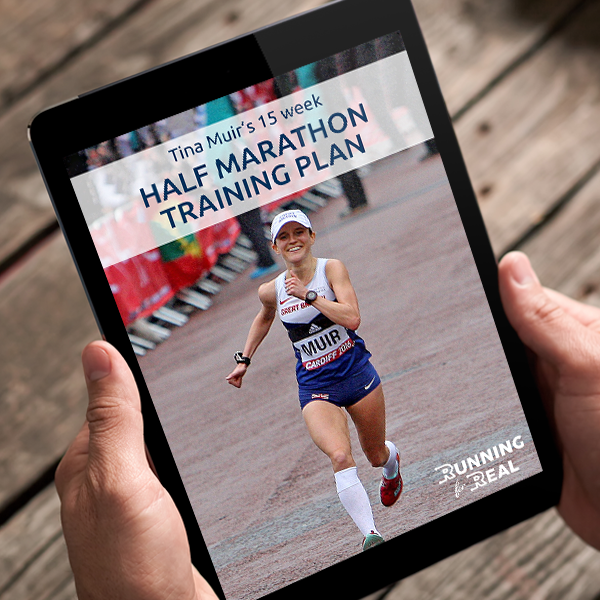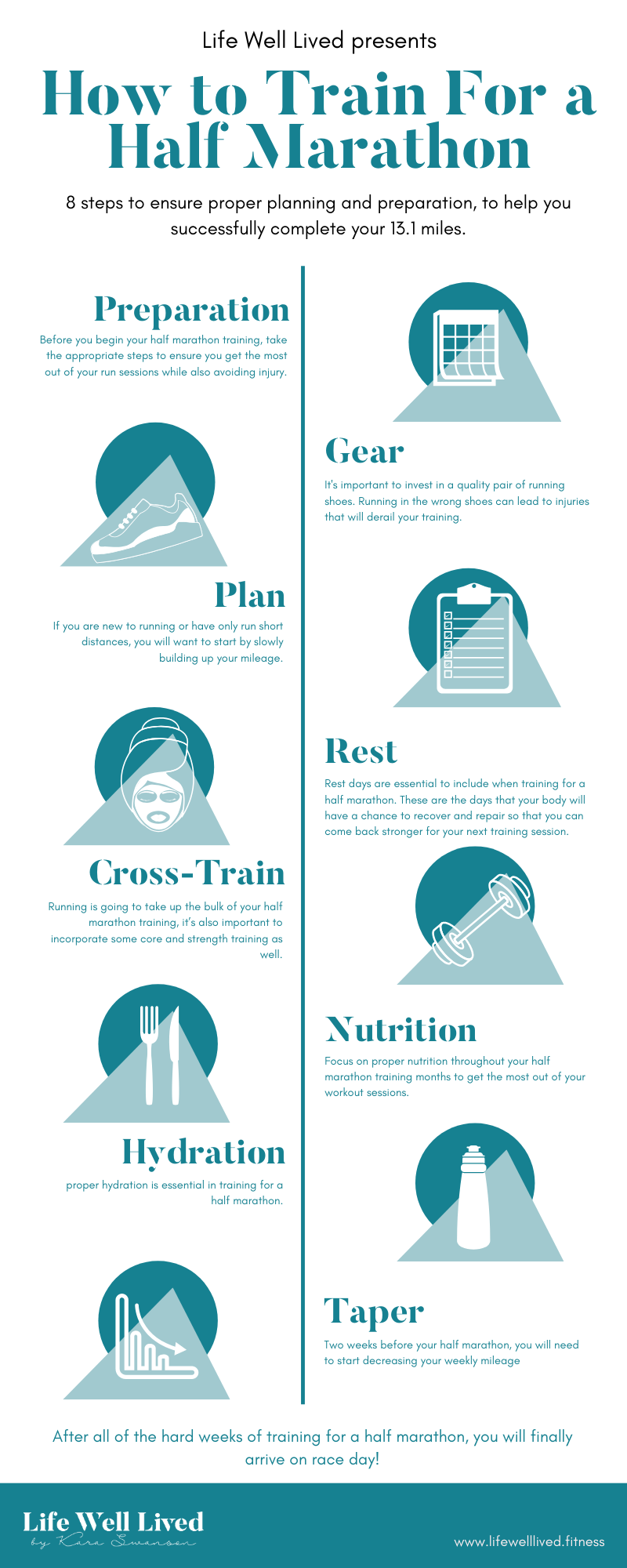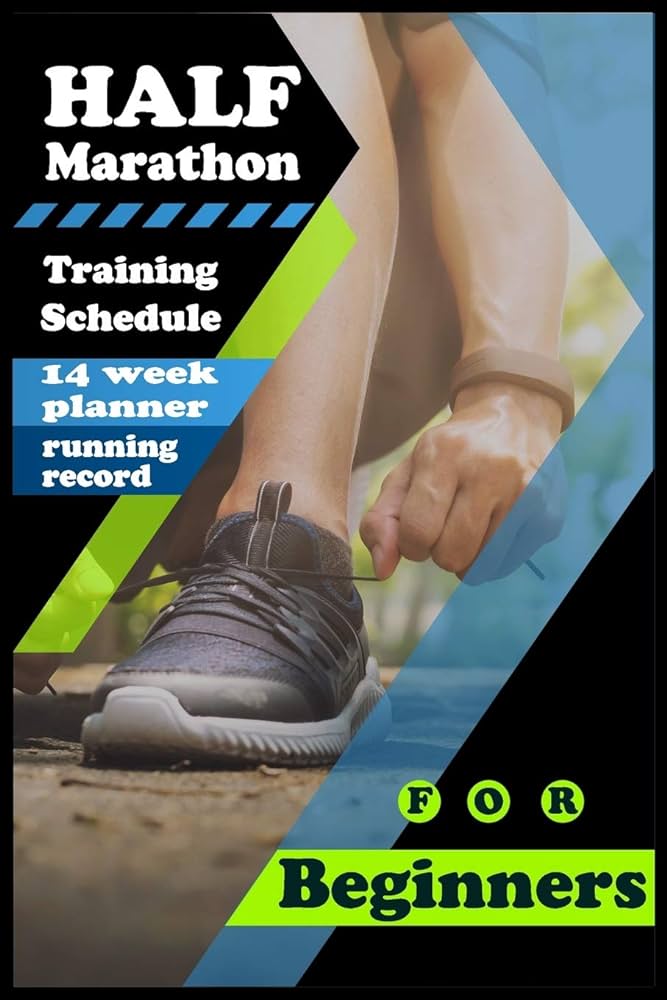Half Marathon Training Step by Step
The step-by-step guide to half marathon training is a concise and accurate plan for runners to prepare for a 13.1-mile race. A well-rounded training program includes gradually increasing mileage, incorporating cross-training exercises, focusing on proper nutrition and hydration, and allowing for sufficient rest and recovery.
By following these steps, runners can build endurance, improve their aerobic capacity, and reduce the risk of injury, ultimately boosting their performance on race day. This comprehensive training approach helps athletes to mentally and physically prepare for the demands of running a half marathon and achieve their personal goals.

Credit: www.pinterest.com
Setting Goals
Setting goals is a crucial step in half marathon training. It’s essential to establish clear objectives to guide your preparation and keep you motivated as you progress through your training journey. Whether you’re a novice runner aiming to finish your first half marathon or a seasoned participant targeting a personal best, setting realistic yet challenging goals is key to success.
Choosing A Race
When choosing a half marathon, consider factors such as the location, course terrain, and timing. Make sure to select a race that aligns with your fitness level and offers the right degree of challenge. Also, factor in the logistics of traveling to the event and the overall race-day experience. Researching and choosing the right race can set the tone for your training and provide the necessary motivation to push through the grueling sessions.
Setting Specific Targets
Establish specific and measurable targets for your half marathon training. For instance, determine a target finish time or aim to run without walking breaks. By setting clear objectives, you can tailor your training plan to focus on the areas that need improvement. These specific targets provide direction and purpose, allowing you to monitor your progress effectively throughout your training period.

Credit: tinamuir.com
Creating A Training Plan
Congratulations! You’ve decided to take on the challenge of running a half marathon. Now, it’s time to create a training plan that will help you reach your goal. Having a structured plan will not only keep you motivated but also ensure that you are progressively building both your endurance and strength. In this step-by-step guide, we will cover everything you need to know about creating an effective training plan for your half marathon journey.
Establishing A Base Mileage
Before diving into intense half marathon training, it’s important to establish a base mileage. This means gradually building up your running distance to a comfortable level. By starting with a solid foundation, you reduce the risk of injury and allow your body to adapt to the demands of long-distance running.
Beginners should aim to run at least three times a week, with a focus on increasing their mileage gradually. Start by running shorter distances, such as 1-2 miles, and gradually increase the distance each week. It’s essential to listen to your body and not push yourself too hard too soon. Remember, slow and steady wins the race!
Incorporating Strength Training
While running is the main focus of your half marathon training, incorporating strength training into your routine is equally important. Strength training helps to prevent muscular imbalances, improve running efficiency, and reduce the risk of injury.
Consider including exercises such as squats, lunges, deadlifts, and core exercises in your training plan. Aim to perform strength training exercises 2-3 times a week, focusing on different muscle groups each day. If you’re new to strength training, it’s advisable to seek guidance from a fitness professional to ensure proper form and technique.
Sample Half Marathon Training Plan
Here’s a sample training plan to give you an idea of how to structure your workouts:
| Week | Monday | Wednesday | Friday | Sunday |
|---|---|---|---|---|
| 1 | 3 miles | 30 minutes strength training | 3 miles | 4 miles |
| 2 | 3 miles | 30 minutes strength training | 3 miles | 5 miles |
| 3 | 3 miles | 30 minutes strength training | 3 miles | 6 miles |
| 4 | 3 miles | 30 minutes strength training | 3 miles | Rest |
| 5 | 4 miles | 30 minutes strength training | 4 miles | 7 miles |
| 6 | 4 miles | 30 minutes strength training | 4 miles | 8 miles |
| 7 | 4 miles | 30 minutes strength training | 4 miles | Rest |
This is just a sample plan, and you should tailor it to fit your individual needs and capabilities. Remember to gradually increase your mileage and always listen to your body. Additionally, make sure to include rest days in your training plan to allow your body to recover and avoid overtraining.
Now that you have a better understanding of creating a training plan for your half marathon, it’s time to lace up your running shoes and embark on this incredible journey. Stay committed, stay focused, and soon enough, you’ll be crossing that finish line with pride!
Nutrition And Hydration
Fueling your body properly and staying hydrated are key aspects of half marathon training. It is important to provide your body with the right nutrients and fluids to sustain your energy levels and prevent dehydration. In this section, we will discuss two important factors: fueling during long runs and hydrating properly.
Fueling During Long Runs
During long runs, your body burns a significant amount of calories and depletes its glycogen stores. It is crucial to provide your body with fuel to keep going strong. Here are some tips on fueling during long runs:
- Consume carbohydrates before your run to provide a source of energy. Opt for easily digestible carbs like bananas, oatmeal, or energy gels.
- During your run, consume carbohydrates every 45 minutes to an hour to sustain your energy levels. Energy gels, sports drinks, or small bites of energy bars can be convenient options.
- Don’t forget to stay hydrated while fueling. Sip on water or a sports drink throughout your run to prevent dehydration.
Hydrating Properly
Hydration is essential for maintaining performance and preventing fatigue during your half marathon training. Here are some guidelines to ensure proper hydration:
- Drink water daily and stay hydrated throughout the day, not just during your runs.
- Before your run, drink about 8-16 ounces of water to ensure your body is properly hydrated.
- During your run, aim to sip on water or a sports drink every 15-20 minutes to maintain hydration.
- After your run, replenish lost fluids by drinking plenty of water or a recovery drink.
Remember, everyone’s hydration needs may vary, so it’s important to listen to your body and adjust accordingly. By fueling properly and staying hydrated, you can optimize your performance and make the most of your half marathon training.

Credit: www.lifewelllived.fitness
Recovery And Rest
Enhance your half marathon training process by prioritizing recovery and rest for optimal performance and injury prevention. Implementing proper rest strategies enables your body to rebuild, repair, and adjust, leading to a stronger and more resilient running routine.
In the journey of half marathon training, recovery and rest play a vital role in helping your body adapt to the physical demands of running long distances. Ignoring the importance of proper recovery can lead to injury and burnout. Therefore, it’s crucial to understand the significance of rest days and how to effectively incorporate stretching and foam rolling into your routine.Importance Of Rest Days
Rest days are a fundamental component of any half marathon training program. Your body needs time to repair and rebuild muscle tissues that have been stressed during training. Rest days also allow your joints, ligaments, and tendons to recover, reducing the risk of overuse injuries. By giving your body time to rest, you will come back stronger and more prepared for your next run.Incorporating Stretching And Foam Rolling
Stretching and foam rolling are essential for maintaining flexibility, preventing muscle tightness, and aiding in recovery. Including dynamic stretching in your pre-run routine can help prepare your muscles for the upcoming workout, while static stretching post-run can promote muscle recovery and reduce soreness. Additionally, incorporating foam rolling into your cool-down routine can help alleviate muscle tension and improve blood circulation, aiding in muscle recovery and reducing the risk of injury. In summary, rest days, stretching, and foam rolling are essential components of half marathon training that should not be overlooked. Integrate these practices into your training regimen to optimize your recovery process and enhance your overall performance. By prioritizing rest and incorporating effective recovery techniques, you can minimize the risk of injury and ensure that your body is adequately prepared for the demands of long-distance running.Race Day Preparation
Introductory paragraph H3: Mental PreparationMental Preparation
Visualize crossing the finish line positively. Stay calm and focused.
H3: Logistics and Gear CheckLogistics And Gear Check
- Arrive early to avoid last-minute rush.
- Ensure your gear is ready and well-fitted.
- Check the weather forecast for adequate clothing.
Frequently Asked Questions For Half Marathon Training Step By Step
How Long Should I Train For Half Marathon?
Aim for 8-12 weeks of training, gradually increasing mileage and incorporating speed work and long runs. Consistent training with a balance of rest can help prepare you for a half marathon. Listen to your body and adjust training as needed.
What Are The Keys To Half Marathon Training?
To train for a half marathon, follow these guidelines: 1. Start with a training plan that gradually increases mileage and intensity. 2. Include a mix of long runs, speed work, and recovery days to build endurance and speed. 3. Incorporate strength training to prevent injuries and improve overall performance.
4. Follow a balanced diet and stay hydrated to support optimal training. 5. Rest and recovery are essential for allowing your body to adapt and avoid overtraining.
How Fast Should A Beginner Run A Half Marathon?
A beginner should aim to run a half marathon at a comfortable pace, focusing on completion rather than speed. There is no specific time requirement for beginners, as it depends on individual fitness levels and goals. It’s important to build endurance and gradually increase speed over time.
Conclusion
Half marathon training requires dedication and a step-by-step approach for success. By following a structured training plan, focusing on nutrition and recovery, and staying motivated, reaching the finish line is within reach. Remember to listen to your body, stay consistent, and enjoy the journey towards achieving your half marathon goals.
Keep pushing, you’ve got this!






